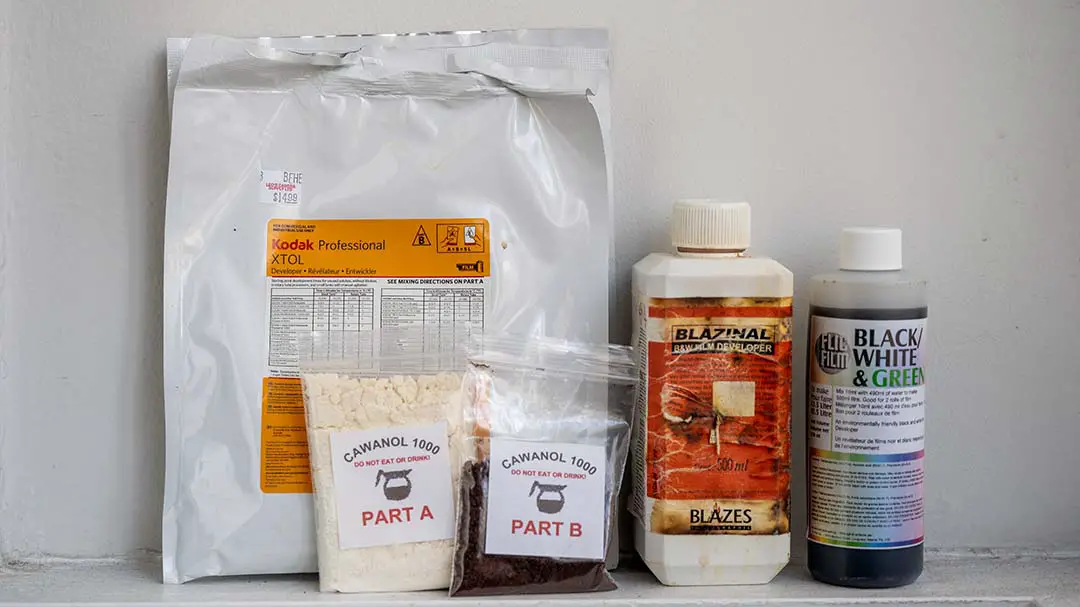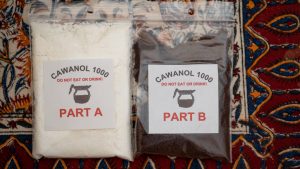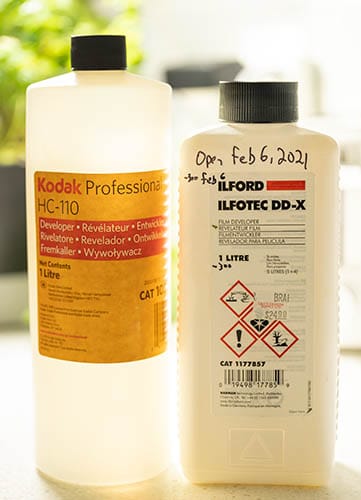Back in its heyday, film photography was one of the biggest environmental disasters on the planet. There were insurmountable levels of toxic chemicals and heavy metals (mostly silver) being dumped down drains around the world.
But today, film photography has become much better. In my conversations with chemical manufacturers, lab creators, and others, there is now a certain understanding of the impact that we are making. Even on the everyday level, consumers around the world
So it’s not surprising that there are actually a good number of options out there for photographers who want to make film development as environmentally friendly as possible.
Companies are cropping up all the time that are dedicated to reducing our environmental impact so that we can keep shooting film for generations. There is even a group in the UK called The Sustainable Darkroom, who are researching new ways to create sustainable developers from plants.
But there’s still a lot of work that needs to be done before we can call film photography a sustainable practice overall. So what are the best developers to help reduce your environmental impact overall?

The #1 most environmentally-friendly developer is caffenol
Caffenol is a developer that you can make at home using instant coffee, Vitamin C, and washing soda. It’s easy to make, smells bad, but develops some pretty cool contrasty negatives.
Most film developers are made from a group of organic molecules called phenols, and it turns out that there are a number of plants that make these in differing quantities. Coffee happens to make one of them, called caffeic acid (which has no relation to coffee or caffeine).
Since coffee beans tend to have different amounts of caffeic acid depending on the variety and the weather conditions, the most reliably consistent source of caffeic acid is instant coffee. Manufacturers make sure that all the components are balanced batch to batch so that it’s the same every time.
Vitamin C, or ascorbic acid, is a common film developer used in many commercial solutions because it lowers the overall base fog caused by grains that weren’t struck by light being developed.
So the chemistry behind caffenol has been studied extensively, and there are plenty of recipes available, like these ones that I have used on caffenol.org.

If you’re not ready to make your own caffenol, there is a company out of Brantford, Ontario, Canada that is making their own caffenol-based developer called Cawanol Professional. I’ve personally used this developer and found that Cawanol Professional can create some surprisingly beautiful results.
What are the most environmentally-friendly film developers that you can buy at the camera store?
If you’re just starting out with film photography, making your own developer at home is like going straight from a deep slumber to running. Many film photographers, myself included, like the convenience of being able to go to a film photography store and picking up reliable, well-documented chemicals.
The most common environmentally-friendly developer is Xtol by Kodak. This is the most recent film developer created by the once mega-corporation and is likely the last that will ever be produced with the amount of funding Kodak was able to throw at it.
Xtol creates beautiful fine-grain negatives, with plenty of details in the shadows. It’s considered to be one of the highest-quality developers available and is particularly suited to faster films like HP5 and Tri-X.
Xtol is a Phenidone and Vitamin C-based developer that comes in a powdered form to make 5L of solution. The developer can be diluted or used straight from the mixed solution, known as the ‘stock’ solution. If you want sharper negatives, use a larger dilution like 1+1 or 1+1, while the stock solution will give the finest grain.
Phenidone is virtually non-toxic in the small quantities needed to develop film. It also doesn’t react with skin, making it a great alternative for people who tend to be sensitive to film developers like hydroquinone.
But Xtol has had some recent issues with the developer going bad before the packaging was opened. These problems have led many film photographers to abandon Kodak in favor of manufacturers like Ilford and other suppliers who haven’t had such substantial quality control issues.
There are two main developers that are based on a similar, environmentally-friendly formula:
- Eco-Pro LegacyPro Ascorbic Acid Film Developer is identical to XTol in every way. It’s a powdered developer in a 5L mix with the same look and development times as Xtol, only with less packaging issues.
- Flic Film Black White and Green: This is also a phenidone and Vitamin C developer, except it comes in an extremely long lasting viscous liquid format similar to the old HC-110. This developer also gives incredible shadow details and beautiful tonality without any toxic side effects. It’s a new player on the market, but should likely be available at major retailers by the end of 2021.
I recently picked up the Flic FIlm Black White and Green developer, and I have to say this is quickly becoming my new favorite. It ticks off all the boxes for me: environmentally friendly, clean, beautiful results, and has an extended shelf life.
Learn more about what Flic Film is and what they plan to do in this article.
What developers have the longest shelf life?
Shelf life is an underappreciated factor in determining which developers are environmentally friendly. The vast majority of developers are rated to last just six months after opening, and only 2 months once they reach the half-full point. It’s easy to waste these developers, and the packaging they came in if you’re not developing a high volume of B&W film.
The two developers that have the longest shelf life after opening are Rodinal (also known as Blazinal in Canada), and now Black, White, and Green by Flic Film. Both of these developers have extremely long shelf lives because they don’t lose their potency when they react with oxygen in the air.
Rodinal, in particular, is famed for being a developer that has a longer shelf life than the shelf it’s stored on. It can change to a deep blackish-red and still develop film as if it didn’t react at all.
HC-110 used to be on this list of long-lasting developers as well. But the reformulation in 2019 changed the way the developer was processed while keeping the same amount of active ingredients. It used to come in a syrupy format that didn’t absorb oxygen (the way Black, White, and Green is formulated now). But the liquid version you see on shelves today doesn’t maintain those long-lasting qualities.
Rodinal and Black, White, and Green also benefit from working with high dilutions. Both of these developers only require 10ml to develop 2 rolls of 35mm film, or 1 roll of 120. Meaning the bottles last forever, and are astoundingly cheap to use. A single 500ml bottle of Rodinal can develop up to 100 35mm rolls, costing only .11 cents per rolls in the USA.
Even though Rodinal uses P-Aminophenol to develop film, the minuscule amounts of the developer and everlasting shelf life make it an environmentally-friendly option. But you can also get the same long-lasting benefits with less harmful chemicals by using Flic Film’s Black, White, and Green developer, which produces similar results to Kodak’s Xtol. I recommend looking into it, and asking your local supplier to order a batch of this developer.
Final thoughts

DD-X has been my primary developer for the last 2 years because of the astounding results it creates. I firmly believe it is the highest-quality developer on the market.
But it isn’t environmentally friendly, and only has a 6-month lifespan. I don’t think I’ve yet been able to finish a bottle of the developer, which has enough capacity for 20 rolls of 35mm, or 10 rolls of 120 when used 1-shot.
After getting similar results with the extremely environmentally-friendly Black, White, and Green developer, I think I’m going to make the switch permanently while keeping Rodinal on the shelf for when I want the sharpest negatives possible.
If you want to learn more about making film photography more sustainable, take a look at this article where I go into the top ways that any film photographer can do at home today to make their practice more sustainable.
And if you have any comments or questions, leave them down in the chat below! I always answer questions as quickly as I can, and love hearing what everyone has to say.

I am trying Xtol split to 5 x 1 litre packages which is about 50 grams each of A and B per mix.
So far so good, time will tell.
I also have very old D76 and Accufine in tin cans that I may split the same way.
I also intend to try FX1 which is said to be the sharpest ever B & W developer.
TB
Let me know how that goes with splitting the bags into 5x 1L bottles. It seems that people are split 50/50 on whether that’s a wise move to make. but I’ve always had a hard time using the full 5L before the solution goes off.
Also, I am very interested in FX1 as well. Read about that one in Troop and Anchell’s Film Photography Cookbook, but haven’t been able to find that one in Canada yet. At some point, I’ll likely just order it from the States and hope for the best.
I’ve put my mixed stock of Xtol into 5 one quart (they will barely hold 1 liter) brown glass bottles. I open one at a time. I also do a film chip test by putting a drop of developer onto a small piece of film and noting how long it takes to turn the film black. So far no sudden developer death syndrome. I am not parsimonious with developer. One shot with stock is fine with me. I figure that if I spend less on chemistry than it costs to send film out I’ve come out ahead.
This is definitely a good way to use it. What’s the longest you’ve been able to keep xtol when it’s been separated out like that?
I have used the Legacy Pro Xtol clone for over a year now. I have a scale and split the A and B parts into 1 litre amounts. I also have a vacuum packer so I reseal the unused portions in their original bags inside a vacuum bag with an oxygen scavenger.
So far this has worked. I use the 1 litre solution stock and usually develope 12 – 15 rolls over a weekend.
So far I haven’t had any issues or sudden death with it.
That’s a great solution. I wish that I could find the Legacy Pro version in a 1L kit, or I’d be using that more often. Thankfully Legacy Pro doesn’t have the same production problems as Kodak Alaris, so you shouldn’t have to deal with any sudden death with the Legacy Pro version.
Hi I am very much a beginner with film developing. I was given 10+ rolls of color c41 film, and want to learn how to develop them in color with the least environmental side effects.
Does anyone know any color developers and fixers that are best for this?
Color film is a standardized process, so there isn’t much choice in the developer you use — there are different kits made by a couple of different companies, but they’re all re-branded versions of the same thing other than the C41 developer by Flic Film out of Alberta, Canada. The best way to make color film developing as environmentally friendly as possible is to store your used chems and take them to a lab for silver recovery and proper disposal — that way you can be sure the contaminants aren’t getting dumped into rivers and streams.